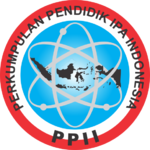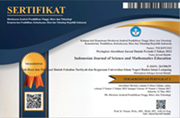Photomath application for learning algebra: Preliminary study on a school in border area
Abstract
This research was motivated by the shift in the educational paradigm toward technology-integrated learning and addresses the disparity in facilities between urban and border area schools. It aimed to determine the effect of Photomath on students' cognitive abilities and to assess their attitudes, motivation, belief, and readiness towards its use in a border area school. The instruments employed were pretest, posttest, and questionnaire. This research serves as an initial study on the use of technology in schools located in border areas. A mixed-method approach was employed, combining qualitative and quantitative analyses. The qualitative analysis of student responses was facilitated by Photomath, while the quantitative method followed a pre-experimental one-group pretest-posttest design. The findings showed a 36.25% improvement in algebra test scores. Students’ learning motivation reached 82.97% (very strong), belief in Photomath was 88.13% (very strong), and readiness to use the Photomath was 78.97% (strong). After using Photomath, students understood each stage of solving algebra problems better, indicating that Photomath supported their learning process. The implication is that integrating Photomath in border-area schools provides valuable support for students, particularly in self-directed learning.
Keywords
Full Text:
PDFReferences
C. Emata, “The Moderating Effect of Technology Attitude on the Relationship between Math Self-Efficacy and Attitudes towards Mathematics,” Unnes J. Math. Educ., vol. 12, no. 1, pp. 1–12, Mar. 2023, doi: 10.15294/ujme.v12i1.62791.
A. A. Romero and E. D. Angeles, “Flipped Classroom in a Digital Learning Space: Its Effect on the Students’ Attitude Toward Mathematics,” Int. J. Learn. Teach. Educ. Res., vol. 22, no. 1, pp. 210–227, Jan. 2023, doi: 10.26803/ijlter.22.1.12.
S. Hwang and T. Son, “Students’ Attitude toward Mathematics and Its Relationship with Mathematics Achievement.,” J. Educ. E-Learn. Res., vol. 8, no. 3, pp. 272–280, 2021.
T. Barkatsas, V. Gialamas, and C. Orellana, “Secondary Students’ Attitudes Toward Learning Mathematics with Computer Algebra Systems (CAS),” in Global Learning in the 21st Century, T. Barkatsas and A. Bertram, Eds., Rotterdam: SensePublishers, 2016, pp. 121–137. doi: 10.1007/978-94-6300-761-0_8.
MMath. T. Coimbra, T. Cardoso, and A. Mateus, “Augmented Reality: An Enhancer for Higher Education Students in Math’s Learning?,” Procedia Comput. Sci., vol. 67, pp. 332–339, 2015, doi: 10.1016/j.procs.2015.09.277.
A. Wijaya, “ALJABAR: TANTANGAN BESERTA PEMBELAJARANNYA,” J. Gantang, vol. 1, no. 1, Art. no. 1, Oct. 2016, doi: 10.31629/jg.v1i1.1.
A. Jupri, P. Drijvers, and M. Van Den Heuvel-Panhuizen, “Difficulties in initial algebra learning in Indonesia,” Math. Educ. Res. J., vol. 26, no. 4, pp. 683–710, Dec. 2014, doi: 10.1007/s13394-013-0097-0.
“Students’ Difficulties In Learning Algebra - Free Essay Example,” Edubirdie. Accessed: Oct. 07, 2024. [Online]. Available: https://edubirdie.com/examples/students-difficulties-in-learning-algebra/
“Use of Photomath Applications in Helping Improving Students’ Mathematical (Algebra) Achievement | European Journal of Education and Pedagogy.” Accessed: Oct. 07, 2024. [Online]. Available: https://ej-edu.org/index.php/ejedu/article/view/601
M. H. Iyad and A. M. Aslan, “Math teachers attitudes towards photo math application in solving mathematical problem using mobile camera,” Educ. Res. Rev., vol. 10, no. 14, pp. 1930–1936, Jul. 2015, doi: 10.5897/ERR2015.2181.
D. M. Nguyen and D. Chen, “PHOTOMATH – A MOBILE APP FOR ALGEBRA TEACHING AND TUTORIALS”.
C. R. I. Permatasari and T. N. H. Yunianta, “E-LEARNING ARTIFICIAL INTELLIGENCE SEBAGAI SUPLEMEN DALAM PROSES METACOGNITIVE SCAFFOLDING PEMECAHAN MASALAH INTEGRAL,” AKSIOMA J. Program Studi Pendidik. Mat., vol. 10, no. 2, p. 829, Jul. 2021, doi: 10.24127/ajpm.v10i2.3490.
M. F. L. Sibuea, M. A. Sembiring, I. Almeina, and R. T. A. Agus, “PEMANFAATAN APLIKASI PHOTOMATH SEBAGAI MEDIA BELAJAR MATEMATIKA,” J. Pemberdaya. Sos. Dan Teknol. Masy., vol. 2, no. 1, p. 109, Apr. 2022, doi: 10.54314/jpstm.v2i1.962.
C. Webel and S. Otten, “Teaching in a World with PhotoMath,” Math. Teach., vol. 109, no. 5, pp. 368–373, Dec. 2015, doi: 10.5951/mathteacher.109.5.0368.
K. Saundarajan, S. Osman, J. A. Kumar, M. F. Daud, M. S. Abu, and M. R. Pairan, “Learning Algebra using Augmented Reality: A Preliminary Investigation on the Application of Photomath for Lower Secondary Education,” Int. J. Emerg. Technol. Learn. IJET, vol. 15, no. 16, p. 123, Aug. 2020, doi: 10.3991/ijet.v15i16.10540.
A. Z. Pikri, P. Yulia, and R. Putri, “Photomath Applications for Learning Mathematics Analysis,” Mathline J. Mat. Dan Pendidik. Mat., vol. 8, no. 2, Art. no. 2, May 2023, doi: 10.31943/mathline.v8i2.322.
“Student Centered Cooperative Learning: Linking Concepts in Education to ... - George M Jacobs, Willy A Renandya - Google Books.” Accessed: Oct. 07, 2024. [Online]. Available: https://books.google.co.id/books?hl=en&lr=&id=5QaWDwAAQBAJ&oi=fnd&pg=PR5&dq=Kiss+M.+LEARNER-CENTERED+MATH+TECHNOLOGY&ots=N2F3cBzhSK&sig=hOHP9UMzEz0SWEgEKi2-1ojj0BQ&redir_esc=y#v=onepage&q&f=false
S. Cai, E. Liu, Y. Yang, and J. Liang, “Tablet‐based AR technology: Impacts on students’ conceptions and approaches to learning mathematics according to their self‐efficacy,” Br. J. Educ. Technol., vol. 50, no. 1, pp. 248–263, Jan. 2019, doi: 10.1111/bjet.12718.
Z. Abidin, A. Mathrani, and R. Hunter, “Student Engagement with Technology Use in Mathematics Education: An Indonesian Secondary School Context,” 2017.
DOI: http://dx.doi.org/10.24042/ijsme.v8i1.24297
Refbacks
- There are currently no refbacks.
Copyright (c) 2025 Unit Riset dan Publikasi Ilmiah FTK UIN Raden Intan Lampung

This work is licensed under a Creative Commons Attribution-ShareAlike 4.0 International License.

Indonesian Journal of Science and Mathematics Education is licensed under a Creative Commons Attribution-ShareAlike 4.0 International License.




